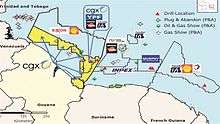Petroleum exploration in Guyana

Guyana has a history of petroleum exploration. Guyana's offshore Guyana Basin and the inland Takatu Basin have attracted companies such as Shell, Total and Mobil since the 1940s who have done much geological surveyance of the area and have drilled a number of wells.[1]
Petroleum production in Guyana is having a major boost to the economy of Guyana.As of 2008, there are four companies undertaking exploration work in Guyana. Exxon-Mobil, Repsol, Century Guyana Ltd. and CGX. The Petroleum Division of the Guyana Geology and Mines Commission has a responsibility of monitoring surveyance in Guyana.
Guyana gained attention in the world in May when ExxonMobil (NYSE:XOM) announced the discovery of more than 90 meters of high-quality, oil-bearing sandstone reservoirs about 120 miles off its coastline. The Liza-1 well was drilled to 5,433 meters in 1,742 meters of water, and is the first well on the Stabroek block, which is 26,800 square kilometers in size. The well, which according to Bloomberg may start producing by the end of the decade, could potentially hold 700 million barrels of oil equivalent — that would make it worth $40 billion at today’s international crude price. The discovery could be significant for Guyana, which currently doesn’t produce any oil and could use the economic boost. It would also give Exxon a much-needed revival after years of declining production and slowing reserves growth — the company’s Q2 earnings reflect that trend, and came to just $4.2 billion compared with $8.8 billion in Q2 2014.[2]
The oil and gas exploration activity by Guyana has been a source of tension with neighboring Venezuela. Back in May 2015, Guyana announced a significant discovery of high quality hydrocarbon reserves, including crude oil, in an offshore concession 190 kilometers (120 miles) off Guyana. The announcement set off a round of recriminations between Venezuela and its eastern neighbor. Officials in Caracas, which has long had claims on Guyana's Essequibo region, have alleged that the concession is located in disputed waters.[3]
Last year, Exxon Mobil announced that they had found a massive offshore column of oil which may hold 700 million barrels or more. The value of that oil dwarfs the roughly $3 billion gross domestic product of Guyana and as Exxon continues development of the well, the small nation is likely looking at a windfall in royalties. For a country of less than a million people, the find changes everything. Within a decade Guyana could be completely transformed by the find going from unpaved roads and sporadic power to being a developed nation.[4]
| Location: | Northern South America, bordering the North Atlantic Ocean, between Suriname and Venezuela | ||
|---|---|---|---|
| Geographic coordinates: | 5 00 N, 59 00 W | ||
| Map references: | South America | ||
| Area: | total: 214,969 km2
land: 196,849 km2 water: 18,120 km2 |
| Land boundaries: | total: 2,933 km | ||
|---|---|---|---|
| border countries (3): | Brazil 1,308 km, Suriname 836 km, Venezuela 789 km | ||
| Coastline: | 459 km | ||
| Maritime claims: | territorial sea: 12 nm
exclusive economic zone: 200 nm continental shelf: 200 nm or to the outer edge of the continental margin |
| Climate: | tropical; hot, humid, moderated by northeast trade winds; two rainy seasons (May to August, November to January) | ||
|---|---|---|---|
| Terrain: | mostly rolling highlands; low coastal plain; savanna in south | ||
| Elevation: | mean elevation: 207 m
elevation extremes: lowest point: Atlantic Ocean 0 m highest point: Mount Roraima 2,835 m |
||
| Natural resources: | bauxite, gold, diamonds, hardwood timber, shrimp, fish[5] |
References
- ↑ www.guyanaguide.com
- ↑ http://investingnews.com/daily/resource-investing/energy-investing/oil-investing/guyana-oil-reserves-exxon-venezuela-feud/. Missing or empty
|title=(help) - ↑ "PressTV-Guyana says offshore oil production soon". www.presstv.com. Retrieved 2016-03-21.
- ↑ "ExxonMobil's Large Offshore Discovery Faces Political Risk | OilPrice.com". OilPrice.com. Retrieved 2016-03-21.
- ↑ "The World Factbook". www.cia.gov. Retrieved 2016-03-21.